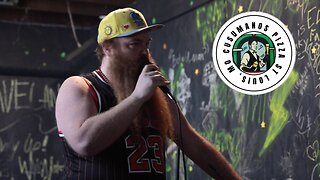Premium Only Content

Data Types in Go: A Beginner's Guide to Powerful Programming #DataTypes #BeginnersGuide
Data Types in Go: Exploring the Basics
Data types play a crucial role in any programming language as they define the nature and behavior of variables. In Go, a statically typed language, data types help programmers organize and manipulate data efficiently. In this article, we'll explore the fundamental data types in Go and understand how they can be used to create powerful programs.
Integers:
Integers represent whole numbers without decimal places. Go provides several integer types, such as int, int8, int16, int32, and int64, which differ in their size and range of values they can hold. The int type's size depends on the underlying architecture, making it a flexible choice for general-purpose integer operations.
Floating-Point Numbers:
Floating-point numbers, or floats, are used to represent numbers with decimal places. Go supports two main floating-point types: float32 and float64. The float64 type provides a larger range and higher precision, making it suitable for most applications. It's important to note that floating-point arithmetic may introduce rounding errors due to the limited precision of these types.
Strings:
Strings are sequences of characters enclosed in double quotes (""). They allow programmers to manipulate and represent textual data. Go's strings are immutable, meaning they cannot be changed once created. To perform operations like concatenation or modification, you need to create a new string. Go providesa rich set of string manipulation functions and supports Unicode characters, enabling robust text processing capabilities.
Booleans:
Booleans represent logical values, either true or false. They are often used in decision-making and conditional expressions. Go's boolean type, bool, provides a straightforward way to handle binary logic and control program flow based on conditions.
Arrays:
Arrays in Go are fixed-size collections of elements of the same type. Once an array is declared, its size cannot be changed. You define an array by specifying the element type and the number of elements it can hold. Accessing elements in an array is done using zero-based indexing. While arrays have their uses, they can be inflexible in dynamic situations.
Slices:
Slices are dynamic and flexible representations of sequences. They provide a more convenient way to work with collections of elements. Slices are based on arrays but can grow or shrink as needed. Unlike arrays, slices don't have a fixed size; instead, they have a length and a capacity. Slices are often used when dealing with lists, sequences, or when dynamically managing data.
Maps:
Maps, also known as associative arrays or dictionaries, provide a way to store key-value pairs. They enable efficient lookups and retrieval of values based on a given key. In Go, maps are unordered collections, and each key must be unique. The map type, map[keyType]valueType, allows you to associate values of any type with a particular key. Maps are commonly used to build data structures for efficient data retrieval and storage.
Structs:
Structs allow you to create custom data types by combining different fields of various types into a single entity. A struct is a collection of named fields, each with its own data type. This provides a way to represent more complex data structures. Structs are commonly used to model real-world entities or define custom data types specific to an application.
Pointers:
Pointers in Go enable direct memory manipulation and can be used to optimize performance or work with external resources. A pointer stores the memory address of a value rather than the value itself. By using pointers, you can modify values directly, avoiding unnecessary copying. However, proper handling of pointers is crucial to avoid
#GoProgramming #DataTypes #BeginnersGuide #ProgrammingTutorial #LearnGo #ProgrammingBasics #Array #Slice #Map #Struct #Pointers #Interfaces #CodingTips #SoftwareDevelopment #ProgrammingConcepts #CodingEducation #CodeLearning #ProgrammingSkills #ProgrammingJourney #TechEducation #GoLang #LearnProgramming
#ProgrammingEducation #ProgrammingFundamentals #BitsBytesCoding #BitsBytesGo #BitsBytesEducation
#BitsBytesBeginners
#BitsBytesSoftware
-
 33:49
33:49
Quite Frankly
1 day agoThe Christmas Eve Midnight Telethon
134K23 -
 2:12:46
2:12:46
Price of Reason
1 day agoAmber Heard BACKS Blake Lively Lawsuit Against Justin Baldoni! Is Disney CEO Bob Iger in TROUBLE?
81.4K24 -
 1:01:17
1:01:17
The StoneZONE with Roger Stone
23 hours agoChristmas Edition: Why the Panama Canal is Part of the America First Agenda | The StoneZONE
150K52 -
 18:12:15
18:12:15
LFA TV
1 day agoLFA TV CHRISTMAS EVE REPLAY
159K19 -
 13:32
13:32
Scammer Payback
1 day agoChanging the Scammer's Desktop Background to his Location
25.5K6 -
 4:21
4:21
BIG NEM
1 day agoNikola Tesla's Secret to Cultivating Creativity & Genius
19.8K1 -
 15:03
15:03
The Anthony Rogers Show
2 days agoAnthony Rogers - Live at Cusumano's Pizza (Upstairs)
15.7K1 -
 4:33:48
4:33:48
tacetmort3m
1 day ago🔴 LIVE - THE ZONE KEEPS PULLING ME BACK - STALKER 2 - PART 15
78.2K13 -
 22:45
22:45
Brewzle
1 day agoI Went Drinking In A Real Bourbon Castle
55.4K4 -
 48:36
48:36
PMG
2 days ago $5.58 earned"Parkland Parent Speaks Out On Kamala Harris Using Victims"
45K12